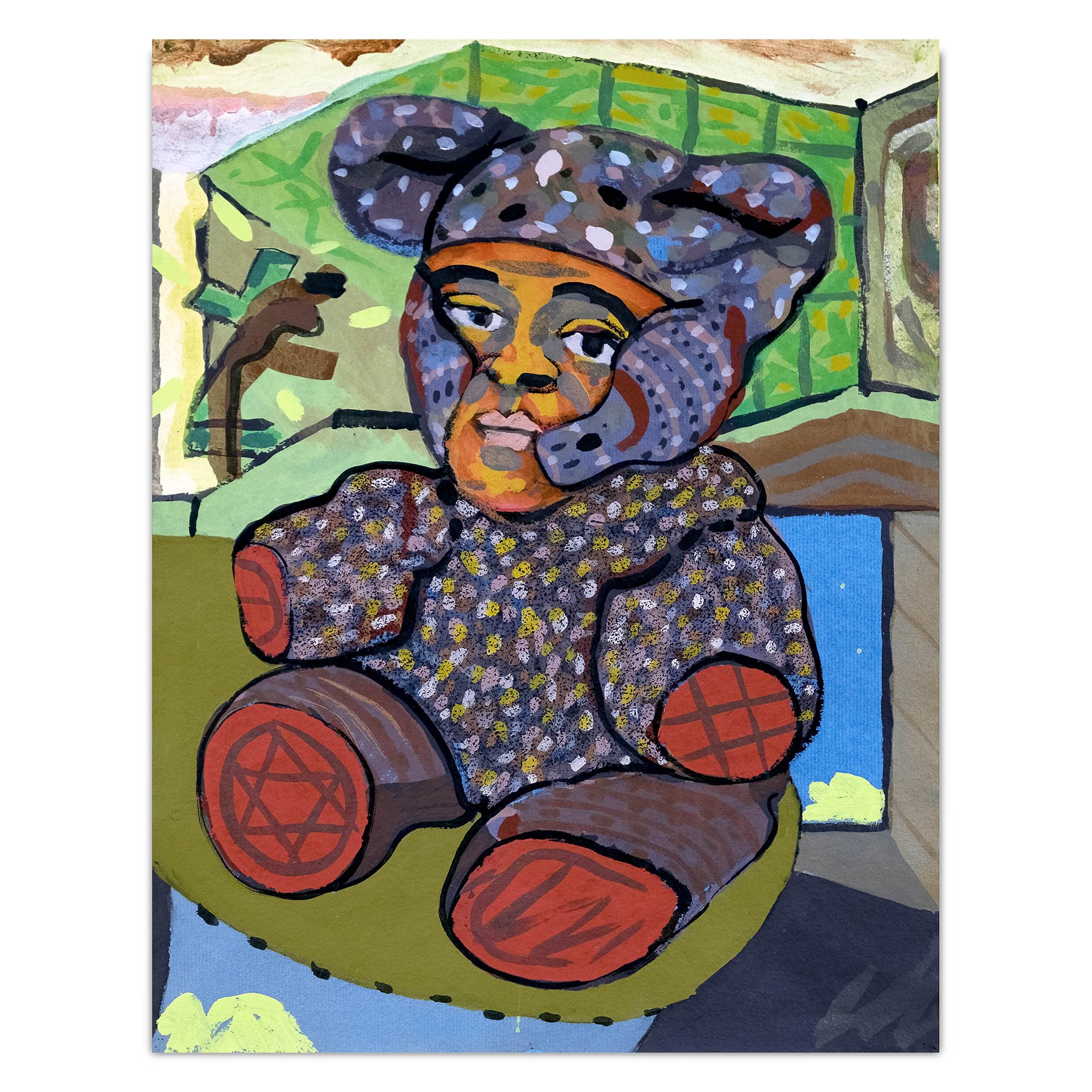Irwin Hollander: The Artist
Untitled (Self portrait as teddy bear), c. 1995-2002. Mixed media on paper. 25 3/4 x 20 inches.
Irwin Hollander was born in 1927 in the Lower East Side of Manhattan, NY, to Henry and Ida (Burak) Hollander, and spent his childhood in Williamsburg, Brooklyn. His mother worked in the garment industry; his father was a taxi driver. Henry died when Irwin was six, and Ida later married Nat Stern, who was also in the needle trades, and active in the garment workers’ union.
Hollander quit his studies at both Hebrew school and public school in the eighth grade and spent two years in Hartford on his own, beyond the jurisdiction of truant oficers. Upon his return, he attended The School of Industrial Art (now the High School of Art and Design) and Washington Irving High School in Manhattan, where he studied fashion illustration, life drawing and photography in night classes.
Following a job taking photographs for advertising at Macy’s, Hollander joined the Army in 1946, which took him to Guam with a photography unit. It was there that he started to read, and discovered painting by way of meeting a Danish artist making watercolors of the tropical beach setting. He bought a set of paints and began his lifelong travels as a painter.
After his army service he returned to New York and used the G.I. Bill to attend Brooklyn Museum Art School for a year. In 1951 he studied at Esmeralda, National School of Painting, Sculpture and Printmaking in Mexico; in 1952, at the Art Students League, New York City.
In an effort to make a living Hollander became a journeyman commercial printer. He married Nina Serser in 1955, and the couple moved to San Diego after the birth of their irst son, Mark. Hollander continued to practice commercial lithography as a trade there and fell in with the art scene. He was subsequently invited to learn and practice at Tamarind Lithography Workshop in Los Angeles by its founder, June Wayne. In 1961 he received a Ford Foundation Grant to develop the program. Within a year he was the first master printer trained at Tamarind, and would oversee the technical achievements that helped to bring fine art lithography back to the forefront of the art world after its long dormancy from an early popularity in Europe.
In 1964, the Hollanders returned to New York to open Hollander Fine Art Lithography Workshop, at 90 E. 10th St in Manhattan. At that time it was the sole fine arts lithography workshop in New York City. He also began teaching at Pratt Graphics Center in 1965. In 1969 Hollander moved the shop to 195 Chrystie Street, and entered partnership with Fred Genis, a Dutch master printer. During the time of the Hollander Workshop, he worked with the most visionary artists of the era, such as Willem de Kooning, Roy Lichtenstein, Sam Francis, Ellsworth Kelly, Louise Nevelson, Robert Motherwell and John Cage. Original prints from the Hollander Workshop now form the bases of important museum and private collections, and are the subject of technical and art history textbooks. The name Irwin Hollander is almost synonymous with that of the renaissance of limited ine art editions of lithography in the US since the 1960s.
After closing the Hollander Workshop in 1972, Hollander taught at various institutions including the Pratt Graduate Center of Fine Arts in New York and Cranbrook Art Academy and Wayne State University in Detroit.
Hollander moved permanently to Wells Bridge, New York in 1984 with his partner, Deanna, and spent the better part of the rest of his life producing his own artwork. He joined the thriving artistic community there and participated in many exhibitions in the region.
He died in 2018 in Brooklyn.
Untitled, c. 1990-1995. Mixed media on board. 8.5 x 11 inches.


